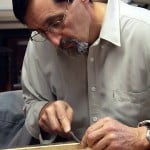Card scraper finish
Welcome! / Forums / General Woodworking Discussions / Card scraper finish
- This topic has 15 replies, 7 voices, and was last updated 11 years, 8 months ago by
 Ron Harper.
Ron Harper.
-
AuthorPosts
-
I can’t make card scraper work well for me. I’ve been trying to scrape a piece of birch (slightly curly, but mostly straight). However I apply the edge on the scraper, the result is “fuzzy”, and feels that way to finger. Looks like the tiny hairs of wood are left uncut.
After planing it (~ half-millimeter chip breaker and throat as closed up as it goes without clogging easily) the finish is glassy smooth and actually slippery to my finger.
With my results I can’t subscribe to scraper being grain direction -tolerant, when scraping across the grain, tearout is heavy.
I do get actual shavings, these are contiguous wisps. Tend to be tightly curled into smallish cigars.. I’ve tried many angles and curving the scraper less seems to produce slightly better results, but still fuzzy..
I flatten scraper with diamond plates, using 90deg block as support, then add edge with tri-burnisher using the least round part, not using heavy pressure. My nail catches on the cutting edge, but it doesn’t seem to catch very easily on the nail surface.
Any clues?
Anonymous28 November 2012 at 12:25 am #3919It sounds as though you have a very good grasp of sharpening scrapers, but perhaps need to spend a little more time burnishing the blade edge and face before turning a shallow angled hook. Edges need to be very well polished in order to produce polished end results and I find the hook is best kept as small as possible and at a shallow angle. They then bite into the surface more readily and tend to leave a more polished finish.
At what angle do you find your scrapers work best? 60 deg to the surface or less?
 28 November 2012 at 8:25 am #3921
28 November 2012 at 8:25 am #3921Interesting question Pasi, and one that echos exactly the issue that I have been having. I do exactly (I think) what you have done and get more or less similar results, but in my case it’s using a Stanley cabinet scraper. I do manage to get an angled hook, but not very pronounced, I’m also not sure that it’s very even across the entire cutting edge.
I’m not at all sure what the purpose of burnishing the blade face is either. I assumed that burnishing was really just for turning over the edge of the blade to make a new, angled, cutting edge?
Glad it’s not just me.
Jon
 28 November 2012 at 8:47 am #3922
28 November 2012 at 8:47 am #3922Hi Pasi,
I have two suggestions.
1, don’t rely on you final finish from diamond stones. I haven’t figured out why yet but scrapers and diamond stones don’t mix well for me. Try wet or dry sandpaper going up to 800-1000 grit (don’t bother stropping).
2, when you turn the edge with the burnisher do so minimally. The smaller the ‘burr’ the better (within reason).
Also, although scrapers will tackle grain nothing else will, don’t tempt fate by going across the grain unless that gets you a better finish. 🙂
 28 November 2012 at 8:50 am #3923
28 November 2012 at 8:50 am #3923You ‘consolidate’ the steel edge by burnishing in line with both the bevel and the flat edge before turning the edge.
Hope this helps.
 28 November 2012 at 10:00 am #3926
28 November 2012 at 10:00 am #3926Thanks Joseph,
What do you mean by consolidate? What does this process achieve? Are you working lengthwise along the edge that you are turning the bevel over onto?
Jon
Anonymous28 November 2012 at 10:24 am #3928This could help ……..http://www.youtube.com/watch?v=iRTVTKi8GIE
Anonymous28 November 2012 at 10:24 am #3929Hi Jon,
Yes. Consolidation of an edge equates to longitudinally compressing, smoothing and polishing it’s surface to an extremely high degree and – with scrapers – enables you to deform it into a hook. In essence you initially consolidate – using a burnisher – the flat side of the scraper directly adjacent to it’s cutting edge before consolidating the thin cutting edge and forming a very fine lateral hook (Roll over) and cutting edge. In essence you work harden, stretch (Beyond the existing crisply stoned edge) and polish the steel to an extremely fine finish – using a burnisher – before deforming the resultant lip to form a hook.
The higher degree of finish, the better the cutting edge. 😉
 28 November 2012 at 1:11 pm #3942
28 November 2012 at 1:11 pm #3942Thanks Ken. That was a great video. Helped a lot.
Thanks Gary. Great explanation on consolidation. The difference on a Stanley #80 (sorry, I didn’t make it clear that was what I was trying to use) is that the blade already has a bevel cut at 45 degrees (I believe). Are you attempting to roll the edge over at the point/tip of that bevel? Do you consolidate the blade in the same way or do you run it along the bevel?
Thanks
Jon
Anonymous28 November 2012 at 4:41 pm #3958Never a problem Jon 🙂 Yes, you consolidate the edge in much the same way with a #80/#080 iron and bunrish the flat side first to compress the face before burnishing the full surface of the 45 degree face. You then rotate the burnisher 10 degrees forward of the leading edge (Away from the bevel) and create the hook. With the #80/#080 standing on a flat work surface, insert the iron into the frame so its edge rests on the surface beneath and tighten the two set screws. Adjust depth of cut by tightening the central screw and you’re set to go. 😉
 28 November 2012 at 6:50 pm #3968
28 November 2012 at 6:50 pm #3968Thanks Gary. I shall give that a whirl tomorrow then report back on progress.
 28 November 2012 at 7:25 pm #3970
28 November 2012 at 7:25 pm #3970The accepted term is more consolidation even though compression works too. Consolidation compels the steel into itself, which then increases the physical strength of the steel to make it more solid. This improves edge retention at the critical corners and it’s this that enables us to ‘turn’ the edge without fracture.
Thanks everybody for suggestions!
I tried some alteration to my edge turning today, but still get these whiskers on the piece of birch that planes just fine. These are almost a millimeter long, become very visible when I drag finger across grain. Without these surface would be glorious, it already reflects light. Scraping fast-growth-pine tears it, largish chunks. I suppose that means the edge is simply not sharp but probably a bit rounded-over. Shavings are shaving-like, not dust; sometimes quite thick.
The fixes I tried today was doing the milling by keeping the file & stone in the vise. Also tried using sandpaper as final flattening stage (only had mirka up to 800, forgot to use an oilstone I actually have). Tried doing initial consolidation for many strokes (20+?). Tried turning the edge only to horizontal level (until fingernail does not catch from wrong direction).
I suspect that diamond plates that have had only relatively little action have donated some of the initial extra diamonds into the scraper. Now scraper being relatively hard metal has them embedded here and there and is maybe also scratching the burnisher. It might be that because the pressure on plate is so easily much greater with scraper the donation happens more easily. If this is so then refiling and using only sand/stone would help me achieve actually sharp pointy end 🙂 Now if only the burnisher would polish back up with the autoglym chrome polisher 🙂
I will continue exercises, there must be a solution.
Anonymous29 November 2012 at 12:00 am #3978Practise is definitely the answer, but I’d suggest easing off the amount of pressure and number of strokes you’re using when burnishing. Two to three firm burnisher strokes should be all you need to use. Aim to create a smaller hook, as the hook should be barely perceptable. This and scraping diagonally with the grain should help reduce your present problem, but try not to be too critical of yourself or your work. Technique and accuracy come with practise and you’ll soon overcome the present plateau. 😉
-
AuthorPosts
- You must be logged in to reply to this topic.
